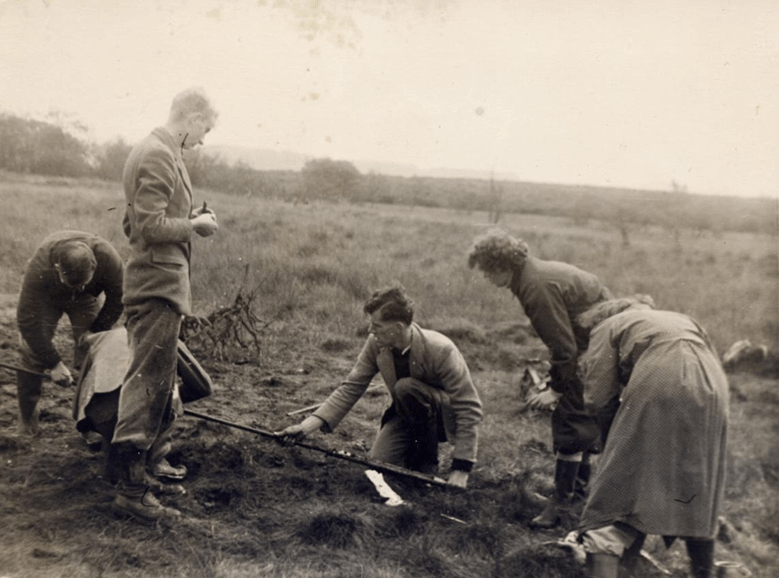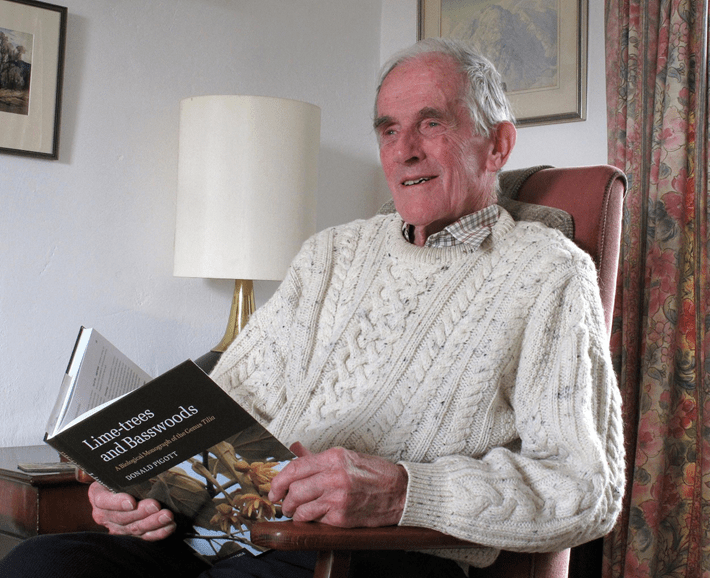Written by Anthony Davy and John Lee.
In a time of increasing specialisation, few British plant ecologists have been as influential on such a broad front as Professor Christopher Donald Pigott, who has died at the age of 94. He served the Journal of Ecology as editor of the Biological Flora of the British Isles and published 18 papers of his own in it over some 66 years. Donald was a champion of a rigorous experimental approach that could address clearly defined questions. This inevitably involved detailed studies of individual species (autecology). His early pursuit of an understanding of climatic limitation led to him being a pioneer of the systematic mapping of individual species distributions. On the other hand, he was also co-director and a leading light of the National Vegetation Classification (NVC), a 16-year phytosociological project involving four universities that led to a comprehensive and systematic catalogue and description of the plant communities of Britain. Other prominent contributions included considerable scientific support for the growing environmental conservation movement, and for forestry as an academic discipline. Not least, his influence can be followed in the scientific achievements of the many doctoral students whom he trained, most notably Professors Philip Grime FRS and Paul Jarvis FRS.
As a member of a distinguished generation of Cambridge botanists that emerged after the second world war, Pigott’s roots were deeply embedded in British plant ecology. He was the last surviving ecologist to have demonstrated his research in the field (experiments on sheep grazing in Padley Wood, Derbyshire) to Sir Arthur Tansley FRS, who had been the first president of the British Ecological Society and founding editor of the Journal of Ecology. Donald was editor of the Biological Flora series (a feature of the Journal of Ecology since 1941) in its formative years, relinquishing the post in 1975 after more than 20 years. He contributed to the series as author and illustrator for longer than anyone else, publishing his first species account (Thymus spp.) in 1955, and his last (Tilia platyphyllos) in 2020 at the age of 92; in between there had been accounts of Polemonium caeruleum (1958), Cirsium acaule (1968) and Tilia cordata (1991). He also served on BES Council in the 1970s, perhaps a more demanding role in the days before the Society had paid staff than it is today. He was joint editor of the New Phytologist (another Tansley legacy) for a number of years from 1961 until his duties as foundation chair of biology in the new University of Lancaster became too onerous.
Donald went up to Emmanuel College, Cambridge in 1946 and took a first in 1949. His phenomenal botanical knowledge was noticed by Dr Max Walters (a future director of the Botanic Gardens there), who became a lifelong influence and friend. Having been awarded a government research studentship and a Shell Scholarship in geology, he changed his intended research topic but was allowed to keep the Scholarship nevertheless! At the suggestion of Walters, Donald spent the summer of 1949 first in Uppsala and then Helsinki, where he was the guest of Jaakko Jalas who was part of the group mapping the distributions of vascular plant species in Europe. This influenced his PhD work at Cambridge, carried out under the supervision of Professor (later Sir) Harry Godwin FRS, on the cytotaxonomy of British Thymus species. He made distribution maps on the Fenoscandian model with small black circles located on the military km grid. Maps based on the 10 x 10 km squares of the National Grid (‘hectads’) were adopted for the first Atlas of the British Flora in 1962 and have now become a ubiquitous mapping standard.
While in Cambridge Donald had been exposed to the developing field of palynology (later working on peat cores from the raised bog at Malham with his first wife, Margaret). He became interested in extant species whose pollen had been identified in the Late Glacial by Godwin. An example of this was Jacob’s Ladder (Polemonium caeruleum) which was still native at its southern limit, on wet, north-facing limestone cliffs in Derbyshire. Appointment to a lectureship at Sheffield in 1951 afforded the opportunity to study the contrasting climates of north- and south-facing cliff faces. To his surprise the north-facing shade temperatures in the growing season matched those of southern Greenland. He complemented this with a similar study of Dwarf Thistle (Cirsium acaule) at its northern limit, where it was restricted to the south-facing limestone slopes. Much of his subsequent work over many years has been an elegant elucidation of mechanisms of climatic limitation in terms of its proximal causes, mainly reproductive failure at suboptimal temperatures. Trees and forestry have featured strongly in this research both before and after he retired. Donald and his second wife Sheila travelled widely in Europe, North America and China to meet fellow scientists, to visit herbaria, but most importantly to observe lime species in the field. Donald became an undisputed international authority on Lime trees: his ‘Lime-trees and Basswoods: a Biological Monograph of the genus Tilia’, published by Cambridge University Press in 2012, is recognised as the definitive treatment. Sheila did much to help Donald bring this monograph to press. Their garden in Cartmel boasts some 20 Lime trees, with species from around the world, including one of Donald’s own naming, Tilia concinna Pigott.
Another major research theme was mineral nutrition and its potential limitations on plant distribution. Simple experiments adding different combinations of mineral salts to various soils clearly revealed the previously underestimated role of phosphorus and its solubility, notably in the classic work with Ken Taylor on stinging nettle (Urtica dioica), published in the Society’s 1964 Jubilee Supplement to the Journal of Ecology. Having established effects in the field, the mechanisms were followed through with experiments in the glasshouse and growth chambers. Donald always expressed a deep distrust for the apparently unfocused accumulation of data without a prior hypothesis, putting himself at odds with ‘comparative ecology’ in an increasingly data-rich world.
An interest in vegetation types may be traced to 1952, when Donald was invited to join a group of highly distinguished botanists on an epic 2000-mile field trip around the Republic of Ireland. However, it was not until after he was appointed head of the biology department at Lancaster University in 1964 that Donald and Dr Derek Ratcliffe, Chief Scientist of the Nature Conservancy Council, instigated the project to classify plant communities, with the aim of underpinning scientific nature conservation and developing a proper understanding of vegetation ecology. The product was eventually published in five volumes (edited by John Rodwell) by Cambridge University Press; it is now the basis for most vegetational survey in Britain and likely to remain so for a long time.
While based in both locations in the north of England Donald espoused important conservation causes. After the notorious construction of Cow Green reservoir in Upper Teesdale was proposed in 1964, he was an expert witness to the parliamentary select committee that the Bill was referred to, having been the author of the only major study of the plant communities of the area (published in the Journal of Ecology in 1956). As the waters rose, he led an emergency ecological investigation into the relict populations of rare plants on the sugar limestone and mitigation of the threats to them. Much valuable information accrued but, sadly, the destruction could not be averted. Nevertheless, the controversy was a turning point in the sense that subsequently more weight was given to environmental issues in major construction projects. There was more success with saving botanically important limestone pavement in Northern England.
The final phase of Donald’s remarkable career began when he succeeded his mentor Max Walters as Director of the Cambridge Botanic Garden in 1984. He returned to a Professorial Fellowship at his old college, Emmanuel. Tenure at the Gardens was dominated by a long war of attrition to preserve the gardens as an important independent resource for teaching and research. Laboratory scientists had designs on its funding and saw its future more as a recreational amenity. Ultimately, he prevailed but always regretted the toll it had taken on his own research. Nevertheless, he was able to renovate the Ecological Mound, 20 years after he had helped build it. Even the Great Storm of 1987 was turned to advantage as it enabled exciting new plantings to replace the losses, some of which had been ‘foundation trees’ from 1846.

His first wife, Margaret, is immediately on his left.
Donald will always be remembered first and foremost for his work on Tilia, and not least for his vital role in bringing the National Vegetation Classification to a successful conclusion. His broader contribution to plant ecology has been, and will continue to be, considerable through his many papers and his influence on distinguished graduate students. In this his strength lay in acute observation of the countryside and its plant communities as a starting point to experimental approaches. Anyone fortunate enough to have been in the field with him will testify to his inspirational insights.
We extend our condolences to Sheila, his daughter Julia Hoggard and their families. We also thank Sheila and Julia very much for their considerable help in the preparation of this obituary.
Donald Pigott’s papers in the Journal of Ecology:
- Pigott, C.D. & Walters, S.M. (1954). On the interpretation of the discontinuous distributions shown by certain British species of open habitats. Journal of Ecology 42(1): 95-116.
- Pigott, C.D. (1955). Thymus L. Journal of Ecology 43(1): 365-387.
- Pigott, C.D. (1956). The vegetation of upper Teesdale in the North Pennines. Journal of Ecology 44(2): 545-586.
- Pigott, C.D. (1958). Polemonium caeruleum L. Journal of Ecology 46(2): 507-525.
- Pigott, C.D. (1962). Soil formation and development on the carboniferous limestone of Derbyshire. I. Parent materials. Journal of Ecology 50(1): 145-156.
- Pigott, C.D. & Taylor, K. (1964) The distribution of some woodland herbs in relation to the supply of nitrogen and phosphorus in the soil. Journal of Ecology 52 (Suppl.): 175-185.
- Martin, M.H. & Pigott, C.D. (1965). A simple method for measuring carbon dioxide in soils. Journal of Ecology 53(1): 153-155.
- Lloyd, P.S. & Pigott, C.D. (1967). Influence of soil conditions on course of succession on chalk of southern England. Journal of Ecology 55(1): 137-146.
- Pigott, C.D. (1968). Cirsium acaulon (L.) Scop. (C. acaule (L.) Weber; Carduus acaulos L.; Cnicus acaulis (L.) Willd.). Journal of Ecology 56(2): 597-612.
- Pigott, C.D. (1969). Status of Tilia cordata and T. platyphyllos on Derbyshire limestone. Journal of Ecology 57(2): 491-504.
- Pigott, C.D. (1970). Soil formation and development on carboniferous limestone of Derbyshire. II. Relation of soil development to vegetation on plateau near Coombs Dale. Journal of Ecology 58(2): 529-541.
- Waters, S.J.P. & Pigott, C.D. (1971). Mineral nutrition and calcifuge behaviour in Hypericum. Journal of Ecology 59(1): 179-187.
- Jeffrey, D.W. & Pigott, C.D. (1973). Response of grasslands on sugar limestone in Teesdale to application of phosphorus and nitrogen. Journal of Ecology 61(1): 85-92.
- Strugnell, R.G. & Pigott, C.D. (1978). Biomass, shoot-production and grazing of two grasslands in Rwenzori National Park, Uganda. Journal of Ecology 66(1): 73-96.
- Pigott, C.D. (1983). Regeneration of oak birch woodland following exclusion of sheep. Journal of Ecology 71(2): 629-646.
- Pigott, C.D. (1991). Tilia cordata Miller. Journal of Ecology 79(4): 1147-1207.
- Pigott, C.D. & Pigott, S. (1993). Water as a determinant of the distribution of trees at the boundary of the Mediterranean zone. Journal of Ecology 81(3): 557-566.
- Pigott, C.D. (2020). Biological Flora of the British Isles: Tilia platyphyllos. Journal of Ecology 108(6): 2638-2676.




